Theme Parks & Themed Entertainment
How does the “Harry Potter and the Escape from Gringotts” ride experience stack up against “Forbidden Journey” ?
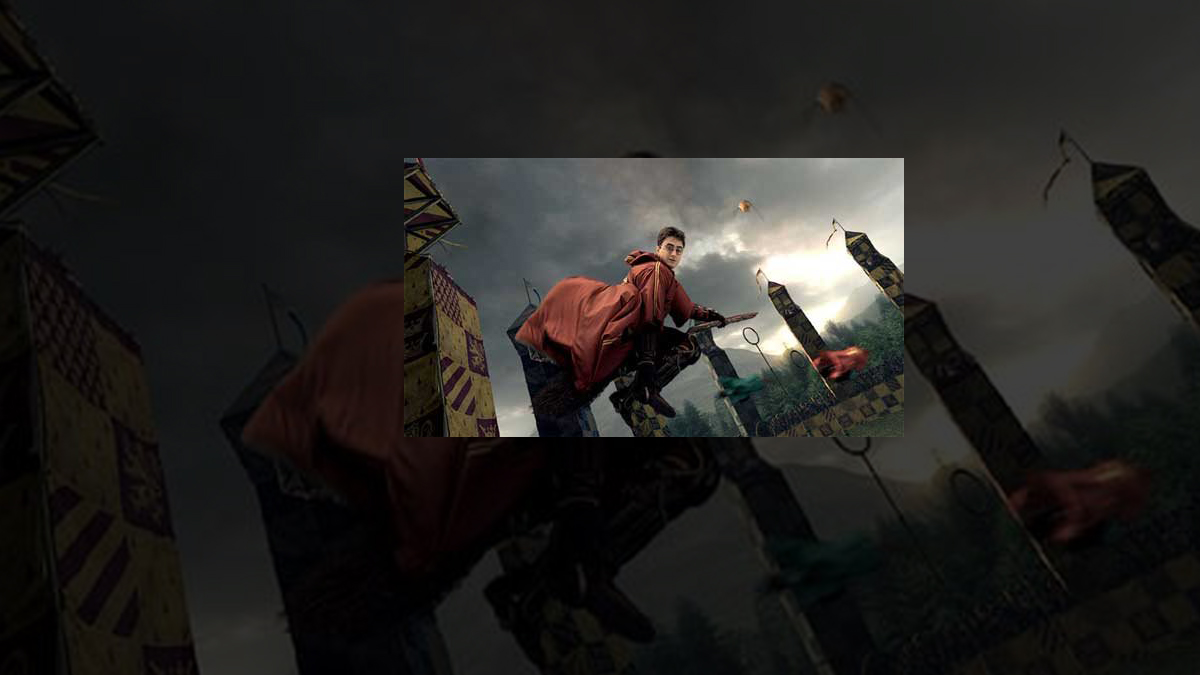
So how exactly does Diagon Alley's marquee attraction —
"Harry Potter and the Escape from Gringotts" — compare to
Hogsmeade's signature ride, "Harry Potter and the Forbidden Journey"
?

Copyright NBC Universal. All rights reserved
Well, before we get started here doing the
compare-and-contrast thing … I think it's important to acknowledge that "Forbidden
Journey" could also be called "Harry Potter's Greatest Hits." Because
— as that Kuka arm powers your flying bench through that massive IOA show
building — you then have all of these very brief but extremely intense
encounters with iconic characters & memorable settings from the Potter
books & movies.
I mean, seriously. Think about it. Within seconds of your flying bench being
dispatched, you're suddenly being (SPOILERS AHEAD for anyone who has yet to ride this 4
year-old Universal Orlando attraction) pursued by this fire-breathing dragon.
Then you're surrounded by massive spiders in the Forbidden
Forest. Once you escape the Forest,
you nearly pulverized by the Whomping Willow before — BANG! — you're right in
the middle of this fierce Quidditch match. And then as the Death Eaters arrive,
you tumble with Harry down into the Chamber of Secrets and … Well, you get
the idead.
And while all of this is going on, you have these blink-and-you'll-miss-them
encounters with your favorite Harry Potter characters. There's Hagrid looking
for his missing dragon. Draco Malfoy accusing Potter of " … showing off
for your Muggle admirers." There's Dumbledore warning you to tuck your
elbows in as your bench flies back to "Forbidden Journey" 's unload
area.
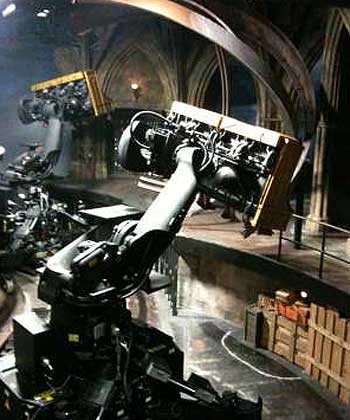
Don't get me wrong. As a fan of the Harry Potter films, when
"Forbidden Journey" first opened in June of 2010, I enjoyed the heck
out of this attraction. And not just because of its Kuka arm-based ride system
brought a real sense of intensity & excitement to the whole "Forbidden
Journey" ride experience, bringing you closer to sets, props & animatronic
figures than had previously been thought possible with more conventional ride
systems.
And given that "Forbidden Journey" 's film
sequences feature the real Harry Potter actors and were actually partially shot
on this movie series' then-still-standing sets at Warner Bros. Studios,
Leavesden … Well, this new Islands of Adventure attraction had a level of
authenticity & immersion that very few theme park rides on this planet had
ever achieved.
That said, "Forbidden Journey" did have some pretty
glaring flaws when it first opened four years ago. Chief among these being that
— at least for its first few months of operation — this attraction's flying
benches weren't exactly fat-friendly. It took a quick redesign of Forbidden
Journey's ride vehicle (which then made the outer two seats on each flying
bench far more accommodating for more ample individuals) to finally make it
possible for 90% of all Universal Orlando visitors to then enjoy &
experience this attraction.
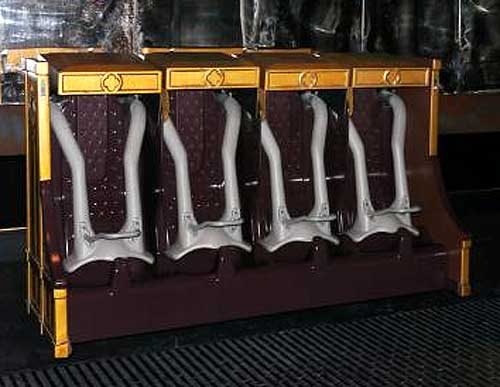
And then there was "Forbidden Journey" 's height
requirement. Which then made it tough for Harry's littlest fans to find out exactly
what was going on inside of Hogwarts Castle.
Not to mention the intensity of the entire "Forbidden Journey"
experience, which — because of that fluid, back-and-forth movement of those
Kuka arms — left some Islands of Adventure visitors nauseous.
Interesting side note here: Because the Japanese are
supposedly so much more motion sensitive than people here in the West are,
Universal Creative developed a somewhat milder / smoother version of
"Harry Potter and the Forbidden Journey." And according to what Seth
Kubersky of the Orlando Weekly told me, Universal Creative actually test-drove
the new version of "Forbidden Journey" at Universal's Islands of Adventure
earlier this year by temporarily substituting the original version of this
attraction's programming for the newer, eventually-headed-to-Universal-Studios-Japan
programming. Given that this milder / smoother version of "Forbidden
Journey" 's programming was deemed a success, it was then shipped off to Osaka.
Where it then began delighting visitors last month when the Japanese version of
The Wizarding World of Harry Potter officially opened to the public on July
15th.
Anyway … Getting back to "Harry Potter and the Escape
from Gringotts" … Ever since the movie-going public saw Harry &
Hagrid go into Gringotts Wizarding Bank in 2001's "Sorcerer's Stone
"
and then rode that Goblin-driven cart through those caverns deep underground
below Diagon Alley, there were Potter fans out there who said "That would
be a really great theme park ride."
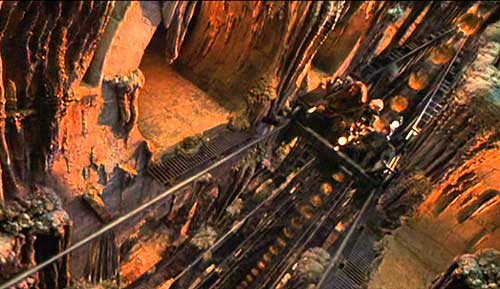
Copyright 2001 Warner Bros. All rights reserved
And then when "Deathly Hallows – Part 2" came out in 2011 and people
saw Harry, Ron and Hermoine's exciting escape from Gringotts aboard a
fire-breathing dragon, the chorus of theme park fans saying "That's a ride
I want to experience. Will someone please build a
Gringotts-mine-cart-deep-underground attraction?" grew louder &
louder.
And Universal Creative — to their credit — listened. Though their takeaway
from all those "We want a Gringotts coaster" cries was a little
different than you might have expected.You see, Universal Creative — after taking a closer look at
"Forbidden Journey" — decided that the next Harry Potter-themed
attraction that they designed wouldn't be another greatest hit ride. This time
around, the Universal Creative team wanted to design an attraction where Potter
fans would then get to spend a lot of time in a single location. Not only that,
but — this time around — Universal Orlando would get plenty of face time with
the books & films' greatest heroes — Harry, Ron & Hermoine — as well
as this series' scariest villains; Bellatrix Lestrange and
he-who-must-not-be-named, Lord Voldemort.
This — to my way of thinking, anyway — is what makes
"Harry Potter and the Escape from Gringotts" an intriguing departure
from "Forbidden Journey." "Escape from Gringotts" is a far
more story-driven experience. Over the course of this 4 & 1/2 minute-long
ride, you visit far fewer places than you did on "Forbidden Journey."
You interact with far fewer characters as well. But at the same time, when
"Escape from Gringotts" is over, Universal Orlando visitors have had a
far richer, more involving ride experience.
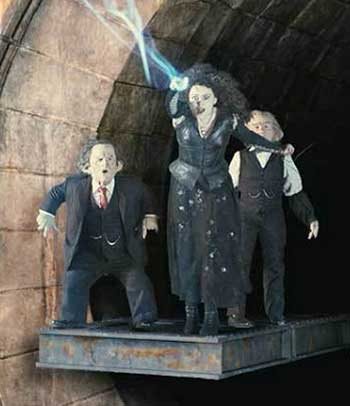
Copyright NBC Universal. All rights reserved
"And why is that exactly?," you ask. Because you've become familiar
with Bill Weasley & Blordak the Goblin before this ride actually got
underway, the stakes are now higher. And then when you encounter Bellatrix
Lastrange, Lord Voldemort and Nagini later in the ride … Because Harry Potter
film fans already know how lethal this trio can be, the scares are bigger and
the stakes are much higher this time around.
Look, I know that there are Potter purists who complain that
what the ride film for "Escape from Gringotts" shows us departs
significantly from what we all previously read in "The Deathly
Hallows" and/or saw in "Deathly Hallows – Part 2." But given
that J.K. Rowling herself signed off on this ride concept when Universal
Creative first pitched it to her three years ago, that the creator of all seven
"Harry Potter" books thought that the storyline proposed for this
attraction was plausible … Well, just because these scenes weren't recounted
in the books and/or depicted onscreen doesn't mean that they also couldn't have
happened.
Speaking of Ms. Rowling, Mark Woodbury — the President of
Universal Creative for Universal Parks & Resorts — revealed that Jo
herself wrote the lines that Bill Weasley says at the very end of this ride.
Which puts a really fun button on this whole ride experience.
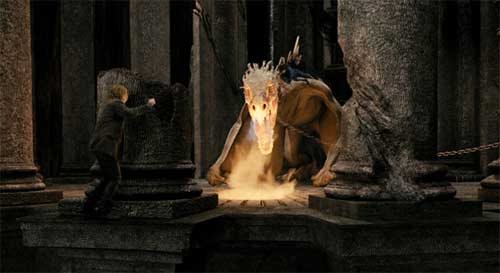
Copyright NBC Universal. All rights reserved
You know what's also fun / different about "Escape from
Gringotts" ? On "Forbidden Journey," there's just four of you —
at best — strapped into that flying bench. Which admittedly makes this ride a
more private & personal experience. But that said, if your three riding
companions aren't the sorts to hoot & holler as they're being whipped
around at the end of that Kuka arm, "Forbidden Journey" can sometime
be a pretty quiet ride experience.
Whereas "Escape from Gringotts" … Well, because
each train that heads out of the station is made up of two carts which can then
each have upwards of 12 people riding aboard them for a total of 24 passengers
being dispatched every 80 seconds … You have much more of a communal
experience going on Diagon Alley's signature attraction. As a group, you're
menaced by trolls in armor. As a group, you spin 360 degrees as Bill &
Blordak try to get you to safety. Which means that you're getting a whole lot
more energy & excitement out of your fellow theme park guests.
And let's not forget about "Harry Potter and the Escape from
Gringotts" super-elaborate queue with all of its animatronic goblins. Or
its Musion-based pre-show where Bill & Blordak quickly sketch out all of
the exposition that you need to understand what's going to happen next (Because
— let's remember — not everyone who visits Universal Studios Florida is going
to be a Potter fan who can then quote from the books and/or knows the films
backwards & forwards). Not to mention your trip 9 miles down into
Gringotts' vaults involves climbing aboard an elevator that's basically a
NextGen version of the Living Seas'
old hydrolators.

Copyright NBC Universal. All rights reserved
The other thing that I really enjoyed about "Escape to
Gringotts" is that — because this is a train-based experience —
Universal Studios Florida was able to lower this ride's height requirement by 2
inches. Which means that even more family members can get in on all this Harry
Potter goodness.
And then when you factor in the clever way that Universal Creative has
reimagined image capture for "Escape from Gringotts"(because — let's
face it — a taken-on-the-ride image of 12 people wearing 3D glasses isn't
exactly something that you'd want to frame and then place on your desk at work)
so that people are now being issued visitor badges for Gringotts Wizarding Bank
… Even the retail side of this attraction is innovative & fun.
So how good is "Harry Potter and the Escape from
Gringotts" really ? So good that a person I know who stood in line on
Opening Day for six hours to experience Diagon Alley's signature attraction and
then — immediately after they got off that ride — got right back in an
equally long line. All with the hope that they might be able to squeeze in one
more ride on Gringotts before Diagon Alley officially closed for the day.
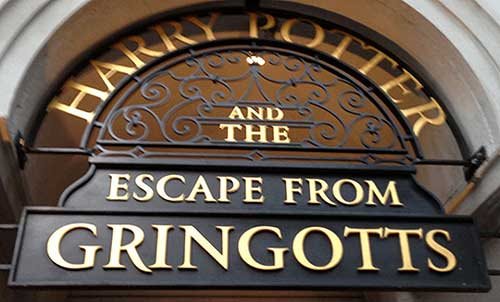
And if that doesn't tell you know good this new Universal
Studios Florida attraction actually is … Well, then you're even more of a Muggle
than I thought.
History
The Evolution and History of Mickey’s ToonTown

Disneyland in Anaheim, California, holds a special place in the hearts of Disney fans worldwide, I mean heck, it’s where the magic began after all. Over the years it’s become a place that people visit in search of memorable experiences. One fan favorite area of the park is Mickey’s Toontown, a unique land that lets guests step right into the colorful, “Toony” world of Disney animation. With the recent reimagining of the land and the introduction of Micky and Minnies Runaway Railway, have you ever wondered how this land came to be?
There is a fascinating backstory of how Mickey’s Toontown came into existence. It’s a tale of strategic vision, the influence of Disney executives, and a commitment to meeting the needs of Disney’s valued guests.
The Beginning: Mickey’s Birthdayland
The story of Mickey’s Toontown starts with Mickey’s Birthdayland at Walt Disney World’s Magic Kingdom. Opened in 1988 to celebrate Mickey Mouse’s 60th birthday, this temporary attraction was met with such overwhelming popularity that it inspired Disney executives to think bigger. The idea was to create a permanent, immersive land where guests could step into the animated world of Mickey Mouse and his friends.
In the early ’90s, Disneyland was in need of a refresh. Michael Eisner, the visionary leader of The Walt Disney Company at the time, had an audacious idea: create a brand-new land in Disneyland that would celebrate Disney characters in a whole new way. This was the birth of Mickey’s Toontown.
Initially, Disney’s creative minds toyed with various concepts, including the idea of crafting a 100-Acre Woods or a land inspired by the Muppets. However, the turning point came when they considered the success of “Who Framed Roger Rabbit.” This film’s popularity and the desire to capitalize on contemporary trends set the stage for Toontown’s creation.
From Concept to Reality: The Birth of Toontown
In 1993, Mickey’s Toontown opened its gates at Disneyland, marking the first time in Disney Park history where guests could experience a fully realized, three-dimensional world of animation. This new land was not just a collection of attractions but a living, breathing community where Disney characters “lived,” worked, and played.
Building Challenges: Innovative Solutions
The design of Mickey’s Toontown broke new ground in theme park aesthetics. Imagineers were tasked with bringing the two-dimensional world of cartoons into a three-dimensional space. This led to the creation of over 2000 custom-built props and structures that embodied the ‘squash and stretch’ principle of animation, giving Toontown its distinctiveness.
And then there was also the challenge of hiding the Team Disney Anaheim building, which bore a striking resemblance to a giant hotdog. The Imagineers had to think creatively, using balloon tests and imaginative landscaping to seamlessly integrate Toontown into the larger park.

Key Attractions: Bringing Animation to Life
Mickey’s Toontown featured several groundbreaking attractions. “Roger Rabbit’s Car Toon Spin,” inspired by the movie “Who Framed Roger Rabbit,” became a staple of Toontown, offering an innovative ride experience. Gadget’s Go-Coaster, though initially conceived as a Rescue Rangers-themed ride, became a hit with younger visitors, proving that innovative design could create memorable experiences for all ages.
Another crown jewel of Toontown is Mickey’s House, a walkthrough attraction that allowed guests to explore the home of Mickey Mouse himself. This attraction was more than just a house; it was a carefully crafted piece of Disney lore. The house was designed in the American Craftsman style, reflecting the era when Mickey would have theoretically purchased his first home in Hollywood. The attention to detail was meticulous, with over 2000 hand-crafted, custom-built props, ensuring that every corner of the house was brimming with character and charm. Interestingly, the design of Mickey’s House was inspired by a real home in Wichita Falls, making it a unique blend of real-world inspiration and Disney magic.
Mickey’s House also showcased Disney’s commitment to creating interactive and engaging experiences. Guests could make themselves at home, sitting in Mickey’s chair, listening to the radio, and exploring the many mementos and references to Mickey’s animated adventures throughout the years. This approach to attraction design – where storytelling and interactivity merged seamlessly – was a defining characteristic of ToonTown’s success.

Executive Decisions: Shaping ToonTown’s Unique Attractions
The development of Mickey’s Toontown wasn’t just about creative imagination; it was significantly influenced by strategic decisions from Disney executives. One notable input came from Jeffrey Katzenberg, who suggested incorporating a Rescue Rangers-themed ride. This idea was a reflection of the broader Disney strategy to integrate popular contemporary characters and themes into the park, ensuring that the attractions remained relevant and engaging for visitors.
In addition to Katzenberg’s influence, Frank Wells, the then-President of The Walt Disney Company, played a key role in the strategic launch of Toontown’s attractions. His decision to delay the opening of “Roger Rabbit’s Car Toon Spin” until a year after Toontown’s debut was a calculated move. It was designed to maintain public interest in the park by offering new experiences over time, thereby giving guests more reasons to return to Disneyland.
These executive decisions highlight the careful planning and foresight that went into making Toontown a dynamic and continuously appealing part of Disneyland. By integrating current trends and strategically planning the rollout of attractions, Disney executives ensured that Toontown would not only capture the hearts of visitors upon its opening but would continue to draw them back for new experiences in the years to follow.
Global Influence: Toontown’s Worldwide Appeal
The concept of Mickey’s Toontown resonated so strongly that it was replicated at Tokyo Disneyland and influenced elements in Disneyland Paris and Hong Kong Disneyland. Each park’s version of Toontown maintained the core essence of the original while adapting to its cultural and logistical environment.
Evolution and Reimagining: Toontown Today
As we approach the present day, Mickey’s Toontown has recently undergone a significant reimagining to welcome “Mickey & Minnie’s Runaway Railway” in 2023. This refurbishment aimed to enhance the land’s interactivity and appeal to a new generation of Disney fans, all while retaining the charm that has made ToonTown a beloved destination for nearly three decades.

Dive Deeper into ToonTown’s Story
Want to know more about Mickey’s Toontown and hear some fascinating behind-the-scenes stories, then check out the latest episode of Disney Unpacked on Patreon @JimHillMedia. In this episode, the main Imagineer who worked on the Toontown project shares lots of interesting stories and details that you can’t find anywhere else. It’s full of great information and fun facts, so be sure to give it a listen!
History
Unpacking the History of the Pixar Place Hotel

Pixar Place Hotel, the newly unveiled 15-story tower at the Disneyland Resort, has been making waves in the Disney community. With its unique Pixar-themed design, it promises to be a favorite among visitors.
However, before we delve into this exciting addition to the Disneyland Resort, let’s take a look at the fascinating history of this remarkable hotel.
The Emergence of the Disneyland Hotel
To truly appreciate the story of the Pixar Place Hotel, we must turn back the clock to the early days of Disneyland. While Walt Disney had the visionary ideas and funding to create the iconic theme park, he faced a challenge when it came to providing accommodations for the park’s visitors. This is where his friend Jack Wrather enters the picture.
Jack Wrather, a fellow pioneer in the television industry, stepped in to assist Walt Disney in realizing his dream. Thanks to the success of the “Lassie” TV show produced by Wrather’s company, he had the financial means to build a hotel right across from Disneyland.
The result was the Disneyland Hotel, which opened its doors in October 1955. Interestingly, the early incarnation of this hotel had more of a motel feel than a hotel, with two-story buildings reminiscent of the roadside motels popular during the 1950s. The initial Disneyland Hotel consisted of modest structures that catered to visitors looking for affordable lodging close to the park. While the rooms were basic, it marked the beginning of something extraordinary.
The Evolution: From Emerald of Anaheim to Paradise Pier
As Disneyland’s popularity continued to soar, so did the demand for expansion and improved accommodations. In 1962, the addition of an 11-story tower transformed the Disneyland Hotel, marking a significant transition from a motel to a full-fledged hotel.
The addition of the 11-story tower elevated the Disneyland Hotel into a more prominent presence on the Anaheim skyline. At the time, it was the tallest structure in all of Orange County. The hotel’s prime location across from Disneyland made it an ideal choice for visitors. With the introduction of the monorail linking the park and the hotel, accessibility became even more convenient. Unique features like the Japanese-themed reflecting pools added to the hotel’s charm, reflecting a cultural influence that extended beyond Disney’s borders.
Japanese Tourism and Its Impact
During the 1960s and 1970s, Disneyland was attracting visitors from all corners of the world, including Japan. A significant number of Japanese tourists flocked to Anaheim to experience Walt Disney’s creation. To cater to this growing market, it wasn’t just the Disneyland Hotel that aimed to capture the attention of Japanese tourists. The Japanese Village in Buena Park, inspired by a similar attraction in Nara, Japan, was another significant spot.
These attractions sought to provide a taste of Japanese culture and hospitality, showcasing elements like tea ceremonies and beautiful ponds with rare carp and black swans. However, the Japanese Village closed its doors in 1975, likely due to the highly competitive nature of the Southern California tourist market.
The Emergence of the Emerald of Anaheim
With the surge in Japanese tourism, an opportunity arose—the construction of the Emerald of Anaheim, later known as the Disneyland Pacific Hotel. In May 1984, this 15-story hotel opened its doors.
What made the Emerald unique was its ownership. It was built not by The Walt Disney Company or the Oriental Land Company (which operated Tokyo Disneyland) but by the Tokyu Group. This group of Japanese businessmen already had a pair of hotels in Hawaii and saw potential in Anaheim’s proximity to Disneyland. Thus, they decided to embark on this new venture, specifically designed to cater to Japanese tourists looking to experience Southern California.
Financial Challenges and a Changing Landscape
The late 1980s brought about two significant financial crises in Japan—the crash of the NIKKEI stock market and the collapse of the Japanese real estate market. These crises had far-reaching effects, causing Japanese tourists to postpone or cancel their trips to the United States. As a result, reservations at the Emerald of Anaheim dwindled.
To adapt to these challenging times, the Tokyu Group merged the Emerald brand with its Pacific hotel chain, attempting to weather the storm. However, the financial turmoil took its toll on the Emerald, and changes were imminent.
The Transition to the Disneyland Pacific Hotel
In 1995, The Walt Disney Company took a significant step by purchasing the hotel formerly known as the Emerald of Anaheim for $35 million. This acquisition marked a change in the hotel’s fortunes. With Disney now in control, the hotel underwent a name change, becoming the Disneyland Pacific Hotel.
Transformation to Paradise Pier
The next phase of transformation occurred when Disney decided to rebrand the hotel as Paradise Pier Hotel. This decision aligned with Disney’s broader vision for the Disneyland Resort.
While the structural changes were limited, the hotel underwent a significant cosmetic makeover. Its exterior was painted to complement the color scheme of Paradise Pier, and wave-shaped crenellations adorned the rooftop, creating an illusion of seaside charm. This transformation was Disney’s attempt to seamlessly integrate the hotel into the Paradise Pier theme of Disney’s California Adventure Park.
Looking Beyond Paradise Pier: The Shift to Pixar Place
In 2018, Disneyland Resort rebranded Paradise Pier as Pixar Pier, a thematic area dedicated to celebrating the beloved characters and stories from Pixar Animation Studios. As a part of this transition, it became evident that the hotel formally known as the Disneyland Pacific Hotel could no longer maintain its Paradise Pier theme.
With Pixar Pier in full swing and two successful Pixar-themed hotels (Toy Story Hotels in Shanghai Disneyland and Tokyo Disneyland), Disney decided to embark on a new venture—a hotel that would celebrate the vast world of Pixar. The result is Pixar Place Hotel, a 15-story tower that embraces the characters and stories from multiple Pixar movies and shorts. This fully Pixar-themed hotel is a first of its kind in the United States.
The Future of Pixar Place and Disneyland Resort
As we look ahead to the future, the Disneyland Resort continues to evolve. The recent news of a proposed $1.9 billion expansion as part of the Disneyland Forward project indicates that the area surrounding Pixar Place is expected to see further changes. Disneyland’s rich history and innovative spirit continue to shape its destiny.
In conclusion, the history of the Pixar Place Hotel is a testament to the ever-changing landscape of Disneyland Resort. From its humble beginnings as the Disneyland Hotel to its transformation into the fully Pixar-themed Pixar Place Hotel, this establishment has undergone several iterations. As Disneyland Resort continues to grow and adapt, we can only imagine what exciting developments lie ahead for this iconic destination.
If you want to hear more stories about the History of the Pixar Place hotel, check our special edition of Disney Unpacked over on YouTube.
Stay tuned for more updates and developments as we continue to explore the fascinating world of Disney, one story at a time.
History
From Birthday Wishes to Toontown Dreams: How Toontown Came to Be

In the latest release of Episode 4 of Disney Unpacked, Len and I return, joined as always by Disney Imagineering legend, Jim Shull. This two-part episode covers all things Mickey’s Birthday Land and how it ultimately led to the inspiration behind Disneyland’s fan-favorite land, “Toontown”. But let’s not get ahead of ourselves here. It all starts in the early days at Disneyland.
Early Challenges in Meeting Mickey
Picture this: it’s the late 1970s and early 1980s, and you’re at Disneyland. You want to meet the one and only Mickey Mouse, but there’s no clear way to make it happen. You rely on Character Guides, those daily printed sheets that point you in Mickey’s general direction. But let’s be honest, it was like finding a needle in a haystack. Sometimes, you got lucky; other times, not so much.

Mickey’s Birthdayland: A Birthday Wish that Came True
Fast forward to the late 1980s. Disney World faced a big challenge. The Disney-MGM Studios Theme Park was under construction, with the company’s marketing machine in full swing, hyping up the opening of Walt Disney World’s third theme park, MGM Studios, in the Spring of 1989. This extensive marketing meant that many people were opting to postpone their family’s next trip to Walt Disney World until the following year. Walt Disney World needed something compelling to motivate guests to visit Florida in 1988, the year before Disney MGM Studios opened.
Enter stage left, Mickey’s Birthdayland. For the first time ever, an entire land was dedicated to a single character – and not just any character, but the mouse who started it all. Meeting Mickey was no longer a game of chance; it was practically guaranteed.

The Birth of Birthdayland: Creative Brilliance Meets Practicality
In this episode, we dissect the birth of Mickey’s Birthdayland, an initiative that went beyond celebrating a birthday. It was a calculated move, driven by guest feedback and a need to address issues dating back to 1971. Imagineers faced the monumental task of designing an experience that honored Mickey while efficiently managing the crowds. This required the perfect blend of creative flair and logistical prowess – a hallmark of Disney’s approach to theme park design.
Evolution: From Birthdayland to Toontown
The success of Mickey’s Birthdayland was a real game-changer, setting the stage for the birth of Toontown – an entire land that elevated character-centric areas to monumental new heights. Toontown wasn’t merely a spot to meet characters; it was an immersive experience that brought Disney animation to life. In the episode, we explore its innovative designs, playful architecture, and how every nook and cranny tells a story.

Impact on Disney Parks and Guests
Mickey’s Birthdayland and Toontown didn’t just reshape the physical landscape of Disney parks; they transformed the very essence of the guest experience. These lands introduced groundbreaking ways for visitors to connect with their beloved characters, making their Disney vacations even more unforgettable.
Beyond Attractions: A Cultural Influence
But the influence of these lands goes beyond mere attractions. Our episode delves into how Mickey’s Birthdayland and Toontown left an indelible mark on Disney’s culture, reflecting the company’s relentless dedication to innovation and guest satisfaction. It’s a journey into how a single idea can grow into a cherished cornerstone of the Disney Park experience.

Unwrapping the Full Story of Mickey’s Birthdayland
Our two-part episode of Disney Unpacked is available for your viewing pleasure on our Patreon page. And for those seeking a quicker Disney fix, we’ve got a condensed version waiting for you on our YouTube channel. Thank you for being a part of our Disney Unpacked community. Stay tuned for more episodes as we continue to “Unpack” the fascinating world of Disney, one story at a time.
-

 History11 months ago
History11 months ago31 Long-Gone Rides, Shows & Attractions at Disney-MGM (Hollywood Studios)
-

 News & Press Releases8 months ago
News & Press Releases8 months agoDisney Will Bring D23: The Ultimate Disney Fan Event to Anaheim, California in August 2024
-

 History4 months ago
History4 months agoFrom Birthday Wishes to Toontown Dreams: How Toontown Came to Be
-

 Theme Parks & Themed Entertainment12 months ago
Theme Parks & Themed Entertainment12 months agoFrom Aladdin to Indy – How Did We Get an Indiana Jones Stage Show at Disneyland?
-

 Film & Movies11 months ago
Film & Movies11 months ago“Indiana Jones and the Search for Indiana Jones”
-

 Theme Parks & Themed Entertainment11 months ago
Theme Parks & Themed Entertainment11 months agoWhen WDW Had a Racetrack – The Creation of the Walt Disney World Speedway
-

 History4 months ago
History4 months agoUnpacking the History of the Pixar Place Hotel
-

 History3 months ago
History3 months agoThe Evolution and History of Mickey’s ToonTown









